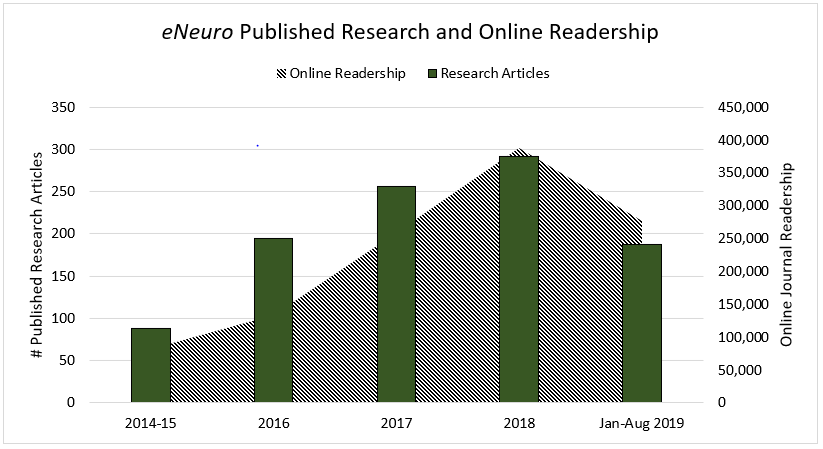SfN Journals: Celebrating Five Years of Innovation
With more than 1,000 published papers, eNeuro is well on its way to becoming the leading open-access neuroscience journal.
Since the launch of JNeurosci in 1981, SfN has published some of the most read and trusted research on the brain and nervous system. In 1996, JNeurosci was among the first scientific journals to take its content online. The transition from print to digital enabled publishers like SfN to reimagine how research is communicated and disseminated. It was in this spirit of innovation that the Society’s online-only journal eNeuro was born in 2014.
Rise of The Open Access Mega Journal and eNeuro
Unbound from the constraints of paper and ink, digital publishing gave rise to a new type of scholarly journal. Such publications feature flexible article structures and a peer review process focused on the technical merits of the research rather than its perceived novelty or importance and are free to read upon publication. Open access “mega journals” such as PLOS ONE and Scientific Reports boast high acceptance rates and rapid publication. However, their large publication volume and transdisciplinary scope can make it difficult for authors and readers to keep up with knowledge in their field.
SfN convened a Working Group on New Publications in 2012 to explore how the Society would best adapt to and remain a leader in this rapidly changing publishing landscape. Based on surveys of SfN members and JNeurosci authors, the group proposed “a quality publication that would act as an incubator for incremental experimentation with emerging publishing and peer review concepts.” They envisioned this new publication as the first successful, high-quality open-access neuroscience journal. Five years and more than 1,000 published papers later, eNeuro is well on its way to achieving that lofty goal.

Rapid Review and Publication
A key factor in eNeuro’s success is its rapid review process. Authors receive a first decision from eNeuro within one month of submission. The editorial board limits the amount of additional experiments reviewers may request (generally to those requiring no more than three months of additional work), further expediting the review process. Accepted manuscripts are published online within days of payment of the publication fees, which support the journal and are reinvested in the Society’s service to the field.
Fair and Constructive
eNeuro is distinguished by double-blind peer review, whereby the identity of both the authors and reviewers are masked. This approach helps eliminate bias by allowing reviewers to focus solely on the research.
“I’m not sure that as a young investigator I would have been given the same consideration as a more senior investigator,” said eNeuro author William Stacey, an assistant professor of neurology and biomedical engineering at the University of Michigan. “I could say things [in this paper] because I was anonymous that I would have been afraid to under different circumstances.”
“As both an editor and a reviewer, and an author, I appreciate getting a clear, concise list of what the reviewers want in order to get the paper published.”Thomas McHugh
RIKEN Brain Science Institute
The journal’s consensus approach to peer review provides authors with a clear roadmap for what is needed to prepare their manuscript for publication.
“As both an editor and a reviewer, and an author, I appreciate getting a clear, concise list of what the reviewers want in order to get the paper published,” said Thomas McHugh of the RIKEN Brain Science Institute.
“[Editors] try to distinguish what the reviewers want and what the paper needs,” added Jeffrey Blaustein, director of the Neuroscience and Behavior Program at the University of Massachusetts, Amherst.
Open and Transparent
eNeuro was founded on the principal of open scientific exchange. To this end, all content in the journal is published under a Creative Commons License. Additionally, the journal accepts important research that might otherwise not even be considered for review elsewhere — namely, negative results and replication studies.
“[eNeuro] lets people who have contradictory data or negative data get their work out there. Because negative results save a lot of time and money,” said Karen Szumlinski, professor at the University of California, Santa Barbara.
“[eNeuro] lets people who have contradictory data or negative data get their work out there. Because negative results save a lot of time and money.”Karen Szumlinski
The University of California, Santa Barbara
The pressure to publish in “high-impact” journals led to “a strange co-production between scientists and [commercial] journal editors, with the former increasingly pursuing discoveries that would impress the latter,” wrote Stephen Buranyi in The Guardian. In contrast, society journals like eNeuro and JNeurosci are managed by active research scientists who are authors themselves. By centering scientists on both sides of the publishing process, eNeuro provides crucial information on replicability and negative results for the entire neuroscience community.
As the publishing landscape continues to change, eNeuro will continue to adapt along with it. eNeuro encourages its authors to contribute to the evolution of both the journal and field by joining the discussion at blog.eneuro.org.
--
Follow @SfNJournals on Twitter, like SfN on Facebook, and sign up for JNeurosci and eNeuro alerts to keep up with the latest research.



















